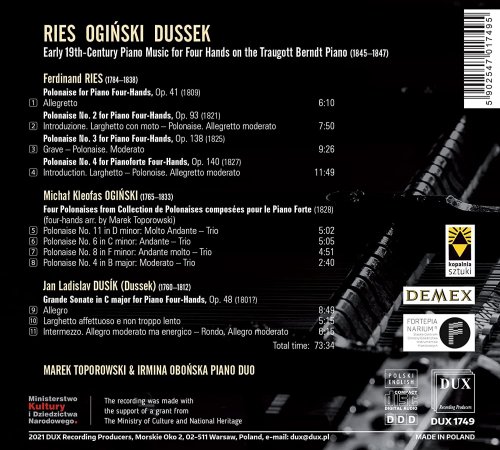
Marek Toporowski & Irmina Obońska Piano Duo - Early 19th-Century Piano Music for 4 Hands on the Traugott Berndt Piano (1845-1847) (2021)
BAND/ARTIST: Marek Toporowski, Irmina Obońska Piano Duo
- Title: Early 19th-Century Piano Music for 4 Hands on the Traugott Berndt Piano (1845-1847)
- Year Of Release: 2021
- Label: DUX
- Genre: Classical Piano
- Quality: flac lossless (tracks)
- Total Time: 01:13:13
- Total Size: 250 mb
- WebSite: Album Preview
Tracklist
01. Polonaise No. 1 in C Major, Op. 41
02. Polonaise No. 2 in B-Flat Major, Op. 93
03. Polonaise No. 3 in E-Flat Major, Op. 138
04. Polonaise No. 4 in D Major, Op. 140
05. Collection de polonaises (Excerpts Arr. M. Toporowski for Piano 4-Hands): No. 11 in D Minor, Molto andante
06. Collection de polonaises (Excerpts Arr. M. Toporowski for Piano 4-Hands): No. 6 in C Minor, Andante
07. Collection de polonaises (Excerpts Arr. M. Toporowski for Piano 4-Hands): No. 8 in F Minor, Andante molto
08. Collection de polonaises (Excerpts Arr. M. Toporowski for Piano 4-Hands): No. 4 in B-Flat Major, Moderato
09. Grande sonate for Piano 4-Hands in C Major, Op. 48, C. 186: I. Allegro
10. Grande sonate for Piano 4-Hands in C Major, Op. 48, C. 186: II. Larghetto affettuoso e non troppo lento
11. Grande sonate for Piano 4-Hands in C Major, Op. 48, C. 186: III. Intermezzo. Allegro moderato ma energico - Rondo. Allegro moderato

Starting in the second half of the 18th century, keyboard (especially piano) music was a peculiar area of artistic work developed mainly for the purpose of music-making in bourgeois homes. An important part of this repertoire is comprised of transcriptions intended originally for larger ensembles; thus, the texture of works for four hands is closer to that of compositions for orchestra than for piano. The fact that the works were performed in a home environment or in a situation of master-student contact also assumes a certain intimacy manifest in the frequent crossing of the left hand of the performer playing the primo part and the right hand of the performer playing the secondo part. The aforementioned two elements are quite visible in the first masterpieces of the genre: the sonatas written by Wolfgang Amadeus Mozart for himself and his sister Nannerl. De facto, the later 19th-cen-tury literature for four hands follows in considerable measure the trail blazed by Mozart. Of course, in many works, there is also no lack of virtuosic elements. The expansion of the piano keyboard range was also conducive to systematic and complete exploration of the freshly-gained areas of the instrument’s range. The broad four-hands texture represents a superb field for this type of procedures, as is quite visible, for example, in one of Ferdinand Ries’ polonaises. The present album presents a stylistically diverse selection of works composed in the first half of the 19th century, selected to display as fully as possible the capabilities of the piano built between 1845 and 1847 by the Traugott Berndt company, an instrument whose sound characteristics are eminently appropriate to the works being performed, despite its being of later date relative to these works.
01. Polonaise No. 1 in C Major, Op. 41
02. Polonaise No. 2 in B-Flat Major, Op. 93
03. Polonaise No. 3 in E-Flat Major, Op. 138
04. Polonaise No. 4 in D Major, Op. 140
05. Collection de polonaises (Excerpts Arr. M. Toporowski for Piano 4-Hands): No. 11 in D Minor, Molto andante
06. Collection de polonaises (Excerpts Arr. M. Toporowski for Piano 4-Hands): No. 6 in C Minor, Andante
07. Collection de polonaises (Excerpts Arr. M. Toporowski for Piano 4-Hands): No. 8 in F Minor, Andante molto
08. Collection de polonaises (Excerpts Arr. M. Toporowski for Piano 4-Hands): No. 4 in B-Flat Major, Moderato
09. Grande sonate for Piano 4-Hands in C Major, Op. 48, C. 186: I. Allegro
10. Grande sonate for Piano 4-Hands in C Major, Op. 48, C. 186: II. Larghetto affettuoso e non troppo lento
11. Grande sonate for Piano 4-Hands in C Major, Op. 48, C. 186: III. Intermezzo. Allegro moderato ma energico - Rondo. Allegro moderato

Starting in the second half of the 18th century, keyboard (especially piano) music was a peculiar area of artistic work developed mainly for the purpose of music-making in bourgeois homes. An important part of this repertoire is comprised of transcriptions intended originally for larger ensembles; thus, the texture of works for four hands is closer to that of compositions for orchestra than for piano. The fact that the works were performed in a home environment or in a situation of master-student contact also assumes a certain intimacy manifest in the frequent crossing of the left hand of the performer playing the primo part and the right hand of the performer playing the secondo part. The aforementioned two elements are quite visible in the first masterpieces of the genre: the sonatas written by Wolfgang Amadeus Mozart for himself and his sister Nannerl. De facto, the later 19th-cen-tury literature for four hands follows in considerable measure the trail blazed by Mozart. Of course, in many works, there is also no lack of virtuosic elements. The expansion of the piano keyboard range was also conducive to systematic and complete exploration of the freshly-gained areas of the instrument’s range. The broad four-hands texture represents a superb field for this type of procedures, as is quite visible, for example, in one of Ferdinand Ries’ polonaises. The present album presents a stylistically diverse selection of works composed in the first half of the 19th century, selected to display as fully as possible the capabilities of the piano built between 1845 and 1847 by the Traugott Berndt company, an instrument whose sound characteristics are eminently appropriate to the works being performed, despite its being of later date relative to these works.
Year 2021 | Classical | FLAC / APE
As a ISRA.CLOUD's PREMIUM member you will have the following benefits:
- Unlimited high speed downloads
- Download directly without waiting time
- Unlimited parallel downloads
- Support for download accelerators
- No advertising
- Resume broken downloads


